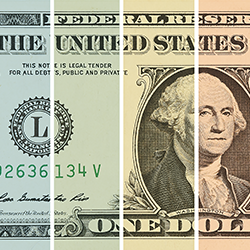|
REGISTRATION REQUIRED
exhibiting 101

PHOTO: ANCH/SHUTTERSTOCK.COM
How to Spend Strategically
Get the most out of your company's exhibit-marketing budget by following these 10 tips for trimming expenses and investing efficiently.
During a budget review, it's easy for novice exhibit managers to experience sticker shock. With the ever-climbing costs of exhibit properties, show services, and travel, fine-tuning your budget is a never-ending battle. And as I explain to new clients, there isn't a magic bullet to solve financial woes when it comes to stretching a show budget to its max. Instead, it's an overall strategic mindset of questioning the value of every line item and analyzing expenses as part of the big picture of a show's overall success.
So how should you allocate your exhibiting budget to make sure every dollar is being used effectively? Here are 10 tips I've developed over the years to help exhibitors optimize their investments while getting the biggest bang for their buck. 1. Exhibit at shows attended by your target audience. It sounds like common sense, but it's not uncommon for companies to keep exhibiting at the same events year after year, assuming that's where they'll find their target audience. In reality, your target audience may no longer be drawn to these events. So conduct an audit of your annual events and ask yourself if you're still getting a solid return on the shows you're attending. Look for the dead weight in your current face-to-face marketing schedule and assess which events you might eliminate if you were able to upgrade to more productive ones. Your goal should be to find the events and shows that attract the highest concentration of attendees in your target market. Do your homework and find out what shows your existing clients attend, research online databases for new shows you may not be aware of, and check the events section of your competitors' websites to see what shows they're attending that you're not. Then either contact show management to inquire about past attendee demographics (and compare them to your target-audience profile to see if there's significant overlap), or consider attending the show to talk with other exhibitors and see for yourself if the event might align with your company's objectives. ➤ Bottom line: Only exhibit at events with the highest concentration of your target audience, where you believe you can generate the highest possible return on investment and lowest cost per qualified lead.2. Make sure your spending correlates with your objectives. Unless you prioritize your reasons for exhibiting and set measurable objectives prior to each show, you could be allocating funds for unnecessary expenditures. For example, if you are exhibiting to increase qualified leads by 20 percent, then your highest discretionary spending should be on a pre-show promotion, in-booth experiential attractions to boost traffic, and travel for additional sales staff to handle the anticipated crowds. However, if you are launching a product or breaking into a new market, your main goal may be to boost awareness of your brand through sponsorships and advertising, in which case your budget allocations should shift accordingly. Similarly, if you're targeting current customers in hopes of up-selling them, you may want to invest in higher-value promotional items than the run-of-the-mill tchotchkes most exhibitors distribute to anyone who'll take them. In contrast, if your primary objective is identifying new business opportunities, you will want your pre-show mailers to go to all preregistered attendees and not just your existing database of prospects. ➤ Bottom line: Only spend your discretionary budget dollars on things that help you reach your goals and objectives. For each line item, ask yourself "Will this spending help me reach my primary goals?" If you're sending a mailer or distributing a giveaway item, ask yourself whether everyone needs to receive it, or if you can cut costs by targeting a specific segment of attendees.3. Consider value before cost. Too often I've witnessed exhibitors acting penny wise but pound foolish when it comes to budget cutting. One client wasted his entire promotional budget on low-quality flashlights, the majority of which didn't work. I'm sure the exhibitor would agree – in hindsight – that the value of functioning flashlights outweighed spending a little more money. I've also seen booth staffers slashed from the roster to cut costs, resulting in an understaffed exhibit full of visitors who tired of waiting to engage with personnel and walked away. Sure, these exhibitors saved money up front, but they did so at the expense of their programs' potential success by giving attendees a negative impression. ➤ Bottom line: When considering how to save a dime, think through the ramifications of each alteration and know when quality is worth the up charge. Don't always choose the cheapest option, and don't arbitrarily eliminate line items. Make sure saving a penny here doesn't ultimately result in several dollars of lost revenue. 4. Think outside the box. Look at each expenditure and ask yourself "How could I do this differently at a lower cost or higher value?" Implement at least one new idea at every show that will improve your results and decrease or hold the line on your costs. Make it a personal challenge to come up with low- and no-cost ways to increase your visibility at each event with minimal investment, like offering your company's executives as conference speakers if a presenter drops out at the last minute. ➤ Bottom line: Get creative. Every dollar you save on expenses can be invested in strategies that improve your exhibit-marketing returns. 5. Opt for lightweight materials. The cost of shipping exhibitry to venues seems to take up a larger percentage of show budgets every year. Consider swapping heavy laminated custom walls with stretched fabric silicon-edge graphics that will cut your shipping, material handling, and labor expenses. Or replace your heavy wooden crates with lighter plastic models that will quickly pay for themselves in reduced shipping and drayage costs. ➤ Bottom line: Trim the fat from your program. Cutting a few pounds here and there will save money long term. 6. Avoid cutting visible elements. Another way to evaluate potential cost-cutting measures is to consider whether or not attendees will be able to see the cutback. Make a T chart, title the two columns "Visible" and "Invisible," and sort your line items. Focus your cost-saving efforts on the budget items that are invisible to show attendees and won't affect your company's image, such as booking a less expensive hotel for your staff and opting to set up your own exhibit. Then spend your "invisible" savings on items that make a positive impact on attendees' perception of your company. Even subtle upgrades like plush carpet with a double pad and new uniforms for your staff can leave a more positive impression. ➤ Bottom line: If you can avoid it, never cut your exhibit budget where a prospect or customer can see it. 7. Meet deadlines and take advantage of early-bird discounts. Scour the exhibitor services manual for the discount deadlines on show services. Simply placing your service orders 15 to 45 days before the show move-in date can make a significant dent in your on-site costs. One trick I've learned is to pad the real dates for discount deadlines on your internal show time line to give yourself a time buffer, especially if you're relying on other team members to provide input before you can place your orders. And remember to check if the official show contractors offer additional discounts for placing orders online. ➤ Bottom line: Take advantage of early-bird discounts and do whatever it takes to avoid ordering products and services on the show floor, where you'll get hit with inflated rates. 8. Sidestep show services. This is a tricky area, as what an exhibitor can do on his or her own is predicated by Byzantine union jurisdictions that vary from city to city and even among shows in the same venue depending on their size. But one reliable strategy is to ship any small boxes to your hotel to avoid material-handling fees. Generally the union governing material handling at conventions has jurisdiction over any four-wheeled device, so if your packages fit on a two-wheeled cart or in a suitcase, you're golden. In fact, this tactic once allowed me to save a client almost $1,200 in drayage fees. ➤ Bottom line: Union regulations are markedly complex, but a thorough reading of the fine print may uncover ways to pinch pennies by doing things on your own. 9. Double-check your invoices. Transparency and itemized billing with back-up documentation are key to knowing what you're paying for basic products and show services. If you're going through the general service contractor (GSC), it's critical to compare your order forms to your final invoice and understand any variances, since honest – and sometimes seemingly intentional – errors can and do occur. Conversely, if your exhibit house is managing your show-site orders for electrical power, labor, Internet, and rental items, it will probably tack on a 25- to 35-percent turnkey fee. You may be more than happy to pay that fee in exchange for the administration. But I've found that if the exhibit house receives a discount or rebate from a vendor, it will often add that markup to the nondiscounted rate. I usually see this double-dipping on shipping invoices and installation-and-dismantle labor hired through exhibitor-appointed contractors. So audit your invoices and have copies of your original orders on hand. ➤ Bottom line: There's nothing wrong with paying a turnkey fee to your exhibit house for the management of your show-service orders, but ask to be shown the true base price of every line item to ensure you're not being overcharged for its oversight.10. Involve your vendors. Even if you're the exhibitor equivalent of an extreme couponer, you should still involve your external vendors in the discussion, as they may have the expertise to help you cut costs without sacrificing effectiveness. Share with them what you need to accomplish, and rely on their insight to help you meet your objectives. Give them sufficient input, a realistic budget, and time, and you'll be astounded by the results – and added value – they can bring to the table. ➤ Bottom line: No exhibitor is an island, and we need the expertise and support of our vendors to maximize our budgeting acumen. E  Candy Adams
Candy AdamsCTSM, CEM, CMP, CMM "The Booth Mom," is an independent exhibit project manager, trainer, speaker, consultant, and an Exhibitor Conference faculty member. CandyAdams@BoothMom.com
|
|
|
||||||||||||||||||||||||||||
|
|
||||||||||||||||||||||||||||
|
TOPICS Measurement & Budgeting Planning & Execution Marketing & Promotion Events & Venues Personal & Career Exhibits & Experiences International Exhibiting Resources for Rookies Research & Resources |
MAGAZINE Subscribe Today! Renew Subscription Update Address Digital Downloads Newsletters Advertise |
FIND IT Exhibit Producers Products & Services All Companies Get Listed |
EXHIBITORLIVE Sessions Exhibit Hall Exhibit at the Show Registration |
ETRAK Sessions Certification F.A.Q. Registration |
EDUCATION WEEK Overview Sessions Hotel Registration |
CERTIFICATION The Program Steps to Certification Faculty and Staff Enroll in CTSM Submit Quiz Answers My CTSM |
AWARDS Exhibit Design Awards Portable/Modular Awards Corporate Event Awards Centers of Excellence |
NEWS Associations/Press Awards Company News International New Products People Shows & Events Venues & Destinations EXHIBITOR News |
||||||||||||||||||||
|
||||||||||||||||||||||||||||






